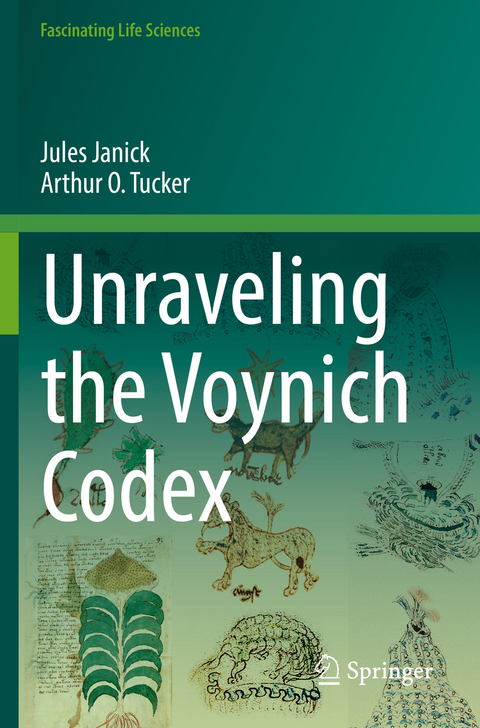
Unraveling the Voynich Codex
Springer International Publishing (Verlag)
978-3-030-08421-9 (ISBN)
Unraveling the Voynich Codex reviews the historical, botanical, zoological, and iconographic evidence related to the Voynich Codex, one of the most enigmatic historic texts of all time.
The bizarre Voynich Codex has often been referred to as the most mysterious book in the world. Discovered in an Italian Catholic college in 1912 by a Polish book dealer Wilfrid Voynich, it was eventually bequeathed to the Beinecke Rare Book and Manuscript Library of Yale University. It contains symbolic language that has defied translation by eminent cryptologists. The codex is encyclopedic in scope and contains sections known as herbal, pharmaceutical, balenological (nude nymphs bathing in pools), astrological, cosmological and a final section of text that may be prescriptions but could be poetry or incantations. Because the vellum has been carbon dated to the early 15th century and the manuscript was known to be in the collection of Emperor Rudolf II of the Holy Roman Empire sometime between 1607 and 1622, current dogma had assumed it a European manuscript of the 15th century. However, based on identification of New World plants, animals, a mineral, as well as cities and volcanos of Central Mexico, the authors of this book reveal that the codex is clearly a document of colonial New Spain. Furthermore, the illustrator and author are identified as native to Mesoamerica based on a name and ligated initials in the first botanical illustration. This breakthrough in Voynich studies indicates that the failure to decipher the manuscript has been the result of a basic misinterpretation of its origin in time and place. Tentative assignment of the Voynichese symbols also provides a key to decipherment based on Mesoamerican languages. A document from this time, free from filter or censor from either Spanish or Inquisitorial authorities has major importance in our understanding of life in 16th century Mexico.
Publisher's Note: For the eBook editions, Voynichese symbols are only rendered properly in the PDF format.
Dr. Jules Janick, James Troop Distinguished Professor of Horticulture at Purdue University, is a renowned editor of scientific journals and has published widely on horticulture, genetics and breeding, horticultural history, art, and iconography. Dr. Arthur O. Tucker, Professor Emeritus at Delaware State University, is the former Director of the Claude E. Phillips Herbarium and is a recognized worldwide authority on plant and herb identification. Fernando A. Moreira, project consultant in Alberta, Canada, is an independent researcher in medical and Mesoamerican iconography (flora and fauna), historical linguistics, and ethnology of pre-Columbian and contact period of Mexico and Guatemala. Dr. Elizabeth A. Flaherty, Assistant Professor, Department of Forestry and Natural Resources, Purdue University has expertise in wildlife ecology and habitat management
INTRODUCTION.- FOREWORD.- PART I. AN INTRODUCTION TO THE VOYNICH CODEX.- The Voynich Manuscript.- Description of Manuscript. Historical Context.- PART II. EVIDENCE OF MESOAMERICAN ORIGINS.- Phytomorph and Mineral Identification.- Plants as the Rosetta Stone for Decipherment.- Zoomorph Identification.- Nymphs and Ritual Bathing.- Zodiac.- Astronomical Images.- Kabbalah Map of Motolinia's Angelopolis.- PART III. DECIPHERMENT.- Cryptological Analyses.- Relation to MesoAmerican Languages.- Progress and Problems in Decipherment. PART IV. THE AUTHOR/ARTIST.- Portrait of the Artist/Author.- Voynich Codex Claimans. Conjecutures, Conclusions, and Future Studies.
"For future research on the codex, I would recommend more engagement with historians, but these authors are to be recognized for their detailed and multi faceted, multi-disciplinary study of this enigmatic work." (Paula Devos, Economic Botany, Vol. 74 (2), 2020)
"The overall impression one has of this remarkable work is that botanical expertise has significantly advanced our understanding of the Voynich Codex. ... Tucker and Janick have given those who have taken an interest in unraveling this mystery outstanding material with which to continue their lively debate over its origins and meaning." (Irwin Goldman, Chronica Horticulturae, Vol. 59 (1), 2019)
| Erscheinungsdatum | 18.02.2019 |
|---|---|
| Reihe/Serie | Fascinating Life Sciences |
| Zusatzinfo | XVI, 412 p. 311 illus., 169 illus. in color. |
| Verlagsort | Cham |
| Sprache | englisch |
| Maße | 155 x 235 mm |
| Gewicht | 652 g |
| Themenwelt | Naturwissenschaften ► Biologie ► Botanik |
| Schlagworte | Ancient manuscript • Botany • cryptography • herbal • Lost language • Mesoamerica • systematic botany |
| ISBN-10 | 3-030-08421-3 / 3030084213 |
| ISBN-13 | 978-3-030-08421-9 / 9783030084219 |
| Zustand | Neuware |
| Haben Sie eine Frage zum Produkt? |
aus dem Bereich


